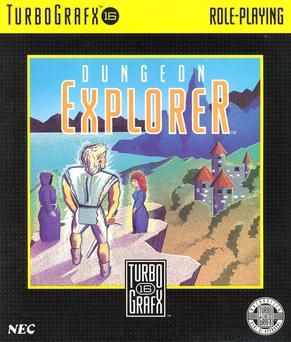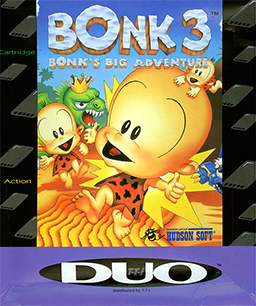
The TurboGrafx-16, known as the PC Engine outside North America, is a home video game console designed by Hudson Soft and sold by NEC Home Electronics. It was the first console marketed in the fourth generation, commonly known as the 16-bit era, though the console has an 8-bit central processing unit (CPU) coupled with a 16-bit graphics processor. It was released in Japan in 1987 and in North America in 1989. In Europe, the console is known as the PC Engine, after the Japanese model was imported and distributed in the United Kingdom and France from 1988. In Japan, the system was launched as a competitor to the Famicom, but the delayed United States release meant that it ended up competing with the Sega Genesis and later the Super NES.
In the history of video games, the fourth generation of video game consoles, more commonly referred to as the 16-bit era, began on October 30, 1987, with the Japanese release of NEC Home Electronics' PC Engine. Though NEC released the first console of this era, sales were mostly dominated by the rivalry between Sega and Nintendo across most markets: the Sega Mega Drive and the Super Nintendo Entertainment System. Cartridge-based handheld consoles became prominent during this time, such as the Nintendo Game Boy (1989), Atari Lynx (1989), Sega Game Gear (1990) and TurboExpress (1990).

Air Zonk, known in Japan as PC Denjin, is a horizontally scrolling shooter released for TurboGrafx-16 in 1992. Air Zonk was an attempt to update the company's image via a modern, punkish character called Zonk, who bears a purposeful resemblance to the TurboGrafx-16's caveman mascot, Bonk.
Bonk, known as PC-Genjin in Japan and as PC Kid or BC Kid in PAL territories, is a video game character and former mascot for NEC's PC Engine/TurboGrafx-16 video game console. Three platform games featuring the character appeared on the PC Engine/TurboGrafx-16, as well as two spin-offs featuring Air Zonk. The protagonist is a bald caveman named Bonk who attacks using his comically large head.

The TurboExpress is an 8-bit handheld game console by NEC Home Electronics, released in late 1990 in Japan and the United States, branded as the PC Engine GT in Japan and TurboExpress Handheld Entertainment System in the U.S. It is essentially a portable version of the TurboGrafx-16 home console that came two to three years earlier. Its launch price in Japan was ¥44,800 and $249.99 in the U.S.
1989 saw many sequels and prequels in video games, such as Phantasy Star II, Super Mario Land, Super Monaco GP, along with new titles such as Big Run, Bonk's Adventure, Final Fight, Golden Axe, Strider, Hard Drivin' and Teenage Mutant Ninja Turtles. The year also saw the release of the Sega Genesis and TurboGrafx-16 in North America, and the Game Boy worldwide along with Tetris and Super Mario Land.

The TurboDuo is a fourth-generation video game console developed by NEC Home Electronics and Hudson Soft for the North American market. The TurboDuo was test-marketed in Los Angeles in October 1992, before a nationwide rollout in May 1993. It is the North American version of the Japanese PC Engine Duo game console which was released in September 1991.

Dungeon Explorer is an action role-playing video game developed by Atlus for the TurboGrafx-16 and originally published by Hudson Soft in Japan on March 4, 1989, and later in North America by NEC on November 15 of the same year. The first installment in the eponymous franchise, the game is set in the land of Oddesia, which has been overrun by an alien race and where players assume the role of one of eight main characters tasked with recovering the Ora stone to kill the alien king Natas. Co-directed by Kazutoshi Ueda and Yōsuke Niino, the title was created by most of the same team that would work on later several projects such as entries in the Megami Tensei series. Though it was initially launched for the TurboGrafx-16, it was later re-released through download services for various consoles.

Bonk's Adventure, known as PC Genjin in Japan and PC Kid in Europe, is a scrolling platform game developed by Red Company and Atlus and released in 1989 in Japan and 1990 in North America for the PC Engine/TurboGrafx-16. The Japanese title PC Genjin is a play on the system's original name, PC Engine, with the European title PC Kid similarly referencing the system's name. The first game in the Bonk series, it was followed by two more games for the TurboGrafx-16 before branching out to other platforms.

Neutopia II is a 1991 action-adventure/action role-playing video game developed and published in Japan by Hudson Soft and in North America by Turbo Technologies for the TurboGrafx-16. It is the sequel to Neutopia, which was released earlier in 1989. In the game, the player takes control of Jazeta's son, who embarks on a quest to both save his father and defeat the returning evil demon Dirth.

Valis III is a 1990 action-platform video game originally developed by Laser Soft, published by Telenet Japan and NEC for the TurboGrafx-CD. A Sega Genesis version was released in 1992. It is the third entry in the Valis series. It stars Yuko Asou, a Japanese teenage schoolgirl chosen as the Valis warrior and wielder of the mystical Valis sword after the events of Valis II. King Glames, wielder of the sword Leethus, leads denizens of the dark world to conquer both Vecanti and Earth, seeking refuge for his people amid the destruction of their planet. Together with the demon warrior-maiden Cham and her sister Valna, Yuko must prevent Glames from destroying both worlds. Through the journey, the player explores and searches for items and power-ups while fighting enemies and defeating bosses.

Wonder Boy III: Monster Lair is a side-scrolling action game developed by Westone Bit Entertainment that was originally released for the arcades by Sega in 1988. It is the third game in the Wonder Boy series and the last one released for the arcade. A console adaptation was made by Hudson Soft, released in 1989 in Japan for the PC Engine CD-ROM² System and the subsequent North American release on the TurboGrafx-CD dropped the 'Wonder Boy III' title. It was also converted and released by Sega for the Mega Drive in Japan in 1990 and Europe in 1991. Both, the TurboGrafx-CD and Mega Drive versions have been re-released for the Wii Virtual Console.

The Legendary Axe is a horizontal platform video game for the TurboGrafx-16. It was developed and published by Victor Musical Industries in Japan and by NEC in North America. It was released in Japan on September 23, 1988 and in North America as a TurboGrafx-16 launch title on August 29, 1989. In the game, the player controls Gogan, a barbarian whose girl, Flare, was kidnapped by the cult of Jagu. The player must navigate through six platforming levels, armed with a legendary axe named "Sting" to defeat Jagu and his minions and rescue Flare. The game features a rechargeable "strength meter" that determines how much damage is dealt from the axe to enemies.

Bonk 3: Bonk's Big Adventure is an action video game released for the TurboGrafx-16 in 1993, the third game in the Bonk video game series.

Gate of Thunder is a 1992 scrolling shooter video game developed by Red Company and published by Hudson Soft for the TurboGrafx-CD. It was the first game released in North America to support the Super CD-ROM² format and served as one of the pack-in games for the TurboDuo, a two-in-one system which runs both TurboGrafx-CD and TurboGrafx-16 titles, where it was bundled with Bonk's Adventure, Bonk's Revenge and Bomberman on the same disc. In the game, the player controls the Hunting Dog space fighter craft, piloted by space cop Hawk. Alongside his ally Esty, piloting the Wild Cat support ship, Hawk must stop General Don Jingi and his Obellon armada from obtaining the powerful "Starlight" energy source from planet Aries.
Super Air Zonk: Rockabilly-Paradise, released in Japan as CD Denjin: Rockabilly Tengoku, is a horizontally scrolling shooter developed by Dual and published by Hudson Soft. It was released for the TurboGrafx-CD/TurboDuo in 1993, and was released on the Wii's Virtual Console on November 19, 2007 in North America, and on January 29, 2008 in Japan.

Lords of Thunder is a 1993 horizontally scrolling shooter developed by Red Company and published by Turbo Technologies and Hudson Soft for the TurboDuo. It is the unofficial follow-up to Gate of Thunder. The player controls the knight Landis, donning the armor of his ancestor Drak on a confrontation against Zaggart of Garuda Empire, who resurrected the evil god Deoric, and his six dark generals across the land of Mistral.

Dark Seal (ダークシール) and Dark Seal II are isometric role-playing beat-'em-up video games released for arcade by Data East in 1990 and 1992 respectively. The first game was localized in English under the title Gate of Doom and the second one as Wizard Fire.

Crystal Crisis is a competitive tile-matching puzzle video game developed and published by Nicalis, released on Nintendo Switch, PlayStation 4 and Microsoft Windows via Steam in 2019. It is inspired by Capcom's Super Puzzle Fighter II Turbo and features crossover appearances by several characters from other Nicalis video games, as well as additional guest characters from companies such as Tezuka Productions.















